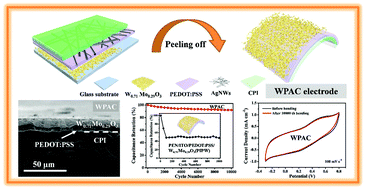An “inverted load” strategy to fabricate interface-optimized flexible electrodes with superior electrochemical performance and ultrastability†
Abstract
With the rapid development of portable electronics, a flexible supercapacitor (SC) is highly desired for energy storage devices due to its fast charging, large capacitance and high energy density. However, inferior interfacial property is a common problem faced by many flexible electrodes, which can result in reduced electrochemical performance and limited stability. Herein, an “inverted load” strategy, which is in contrast to the traditional “forward load” method, is used to deposit the active material, the conductive layer and the flexible substrate sequentially on a glass plate, followed by peeling of the whole film, to fabricate an integrated flexible electrode. This innovative strategy contributes to the strong interlayer adhesion of the electrode, which greatly improves the electrochemical properties and stability. In the integrated electrode, a silver nanowires (AgNWs) network is tightly embedded between the PEDOT:PSS buffer layer and the colorless polyimide (CPI) substrate, which endows this electrode with excellent conductivity and bending stability. A higher specific capacitance (15.8 mF cm−2 at a current density of 0.1 mA cm−2) and an enhanced capacitance retention of 92% after 10 000 CV cycles can be achieved for the W0.71Mo0.29O3/PEDOT:PSS/AgNWs/CPI (WPAC) electrode with W0.71Mo0.29O3 as the active layer, while the PEN/ITO/PEDOT:PSS/W0.71Mo0.29O3 (PIPW) electrode prepared by the traditional “forward load” method only reaches 8.0 mF cm−2 at the same current density with a poor electrochemical cyclic stability of 48% after only 1000 CV cycles. Taking advantage of the superflexibility of the CPI substrate, the electrode can achieve outstanding flexible bending stability with the resistance of the WPAC electrode increasing less than 1% with almost no capacitance loss after 10 000 times of bending with a curvature radius of 500 μm. This novel strategy provides a new perspective on the design and fabrication of a transparent, stable and flexible electrode for electronic devices.



 Please wait while we load your content...
Please wait while we load your content...